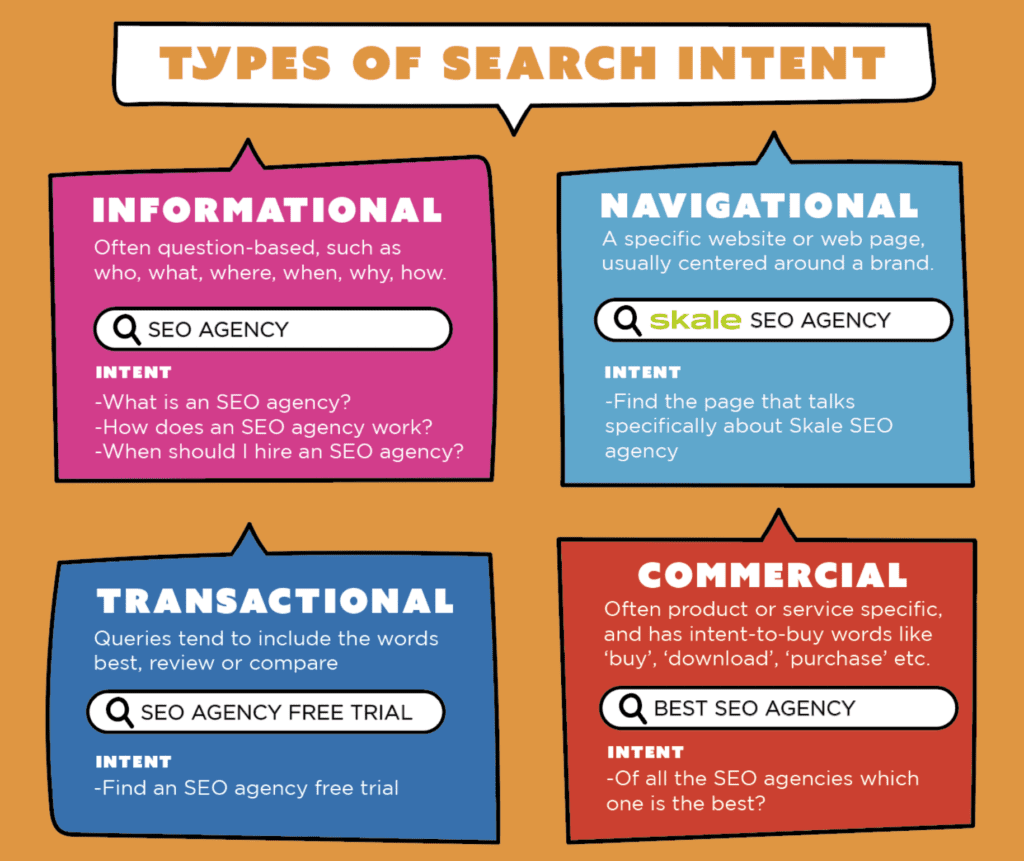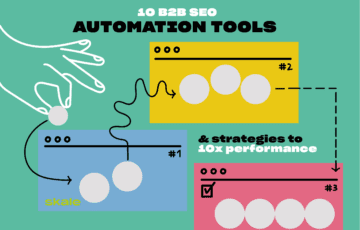
Keywords are the north star of your SEO strategy.
Without knowing what keywords to use and rank for, your SaaS will be getting views and clicks from the wrong people.
Finding the right keywords is not as easy as you might think, but it isn’t impossible either.
The process of finding and using relevant keywords that help you rank is called keyword research. It’s extremely important to do well because it helps drive traffic to your site, reach the right audience, and decrease your bounce rates.
Still don’t think keywords are such a big deal? Check these statistics:
- 68% of online experiences begin with a search engine–which means with a keyword in a search box
- 53.3% of all website traffic comes from organic search–ahem, keywords are the king for organic search
- 69.7% of search queries contain four words or more–also known as long-tail keywords
So, how exactly do you go about building an effective keyword strategy? Keep reading to find out.
How to plan your B2B SaaS keyword strategy
Before conducting your keyword research, you’ll need to take some time to look at competitor research, conduct a customer analysis, and identify your search intent. Let’s break these three things down.
Competitor research 
Take a look at your competition through a competitor analysis. They might have some successful high-traffic keywords for your target market. Make sure to review their keywords (yes, including their PPC keywords used) and backlinks in an SEO tool to learn what content is working for them and identify how you can do it better.
Customer analysis 
Run a customer analysis to find the best keywords for reaching your target audience. The idea is to target potential clients that are looking for exactly what you offer. Having an in-depth and extensive understanding of your customers can help you learn how to successfully understand and answer their questions before they even ask them.
There are many ways to go about conducting a customer analysis. However, here are some best practices:
- Conduct customer interviews
- Review your social platform analytics
- Check product review platforms like G2 or Capterra
Understand search intent 
Understanding search intent is essential. The best B2B keywords are those where the searcher’s intent is clear, and where the intent matches your page content.
Instead, you’ll need to focus on finding keywords that match your services, and products. When you create content for your site, you need to focus on the purpose of the page. When performing keyword research for B2B companies, you need to focus on the journey through the lens of the buyer.
This means your keywords need to be related to each stage of the B2B journey.
Your overall B2B keyword strategy needs to focus on the user intent of the visitor. When users are satisfied with your content, they’re less likely to bounce and leave your page. You need to look beyond what your service is and look towards how it can benefit your clients and help them accomplish their own needs.
Level up your SEO strategy with Skale
See where Skale’s SEO experts can take your MRR. Get in touch, today
Contact UsUnderstanding ToFu, MoFu, and BoFu content
ToFu, MoFu, and BoFu are abbreviations that provide a way of simplifying the discussion around content strategy and content mapping.
What is ToFu content?
Top-of-the-funnel content refers to how you reach new visitors. It deals with how you can attract your target audience and encourage them to share your content. This means creating content that your readers find trustworthy and educational enough that they will like to share it with their friends and network.
For example, podcasts are often used as ToFu to educate your audience about the problems they’re addressing. Better Done Than Perfect is a podcast by Userlist, a SaaS email automation tool. They have episodes about user onboarding, product-market fit, customer research, and many other topics SaaS businesses are interested in, helping them to capture the attention of people that could be interested in what they have to offer.
What is MoFu content?
MoFu, short for middle-of-the-funnel content, is geared toward getting your visitors to act. It works to prompt interaction and inspire leads.
Here, it’s important to establish your experience and subject authority, provide informative, high-quality content, and lead your buyer to understand that your service or product solves their issue.
Utilizing terms like advantages of and benefits of are commonly used in this B2B research stage to help answer the queries of users seeking unbiased and comparative information. You need to make sure your MoFu page deals with specific problems and provides information to help attract the right audience to your page.
For example, Chameleon, a product adoption platform, provides multiple webinars to engage those interested in their product and their solutions. Additionally, these webinars help them improve their thought leadership and be seen as real experts in the eyes of their audience. The webinars often feature their SaaS but aren’t strictly orientated around it. So, they’re addressing a pain point, highlighting their solution, but not selling their solution.
What is BoFu content?
BoFu, short for bottom-of-the-funnel content, attempts to convert your audience’s ideas into action. It works to nurture interest that leads to–paid–conversions.
Now, it’s time to convince your lead that your services and products are better than your competitors. This type of content targets keywords that relate directly to your product or brand. Usually, there are short-tail keywords that consist of two or three words, which makes them more competitive and therefore need high-quality content.
For example, Maze, a tool that empowers your product team by giving them ways to get user insights efficiently, shares their customer success stories. This helps them to prove to those considering them as a solution why they’re the best one there is.
It’s essential to note that content written for different stages of the buyer’s journey will have different successful targets and outcomes.
Are you trying to get sign-ups, make a sale, promote your business, or, raise brand awareness?
You’ll need to define what success means at each stage of the journey.
Measure the ROI of your SEO efforts
Practical methods for accurately measuring the ROI of your SEO strategy + free ROI tracker
Read SEO ROI articleThe B2B keyword research process in 7 steps
The seven most important steps and strategies for a successful keyword research process are:
Step 1: Develop your corner of the market
The first step in starting your keyword research process is diving deep into your niche. Analyze how your target audience sees your brand, services, and products, and identify the topics that can be the foundational keywords for your overall SEO efforts.
Useful ways you can learn about your niche are:
- Interview your current customers: Survey customers you already have to understand their thought processes and ideas. Ask them about how they describe your service, brand, and business.
- Reach out to potential or churned customers: Ask customers for feedback and impressions about what they like or don’t like about your product or service. Having this information can help you understand and improve your customer’s experience with your business.
- Explore different forums: Forums are excellent places to find questions people are already asking about your specialty. Spending time exploring different online forums–like LinkedIn, Quora, and Reddit–can spark a lot of ideas for keywords for your company.
- Use reviews to get the voice of the customer (VoC): Checking SaaS review platforms like G2, Capterra, SoftwareAdvice, GetApp, and wherever else people are writing about you–maybe even Reddit and Facebook posts and threads. Can give you a better idea of how your product is doing and what they are saying about it.
Step 2: Make a list of seed keywords
The second step in the process is to build a list of seed keywords.
A seed keyword is something that your target audience searches online and can connect to various topics. Making a list of these keywords helps you form the foundations of the entire keyword research process.
You can do this by describing your product in the simplest terms possible. Try to get into the mind of your target audience and think about how users will be searching for it online. Choose the most commonly-used keywords that relate to your product and add them to your base list.
Step 3: Find out what keywords your competitors are using
Step three takes a look at the keywords your competitors are using and already ranking for. This step can help you save a lot of time and effort because you can see which ones are currently working in the market you’re trying to disrupt–helping make your life a tiny bit easier.
Find out who your top competitors are by putting your seed words into Google search and working your way through the top results.
It’s important to also analyze the keywords your competitors are using for their PPC campaigns–which ones are their high-converting keywords. As this will give you a broader look at how they are bringing in potential buyers.
Step 4: Identify the most relevant keywords for your goals
In this step, you’ll take your extensive list of potential keywords and work to find out which ones are the most relevant and useful. To find the best keywords for your business you should make sure that the user intent is right and that these keywords are relevant to your ICP. From there, you can compare and sort the keywords based on: search volume, trends, cost per click, and keyword difficulty.
Once you find the ones that fit these criteria, adjust your list accordingly.
Step 5: Group your keywords by search intent
In this step, you’ll work to classify the keywords from your list in terms of their search intent in order to better target your audience.
Search intent directly impacts your ability to rank in the SERPs.
Understanding the reason behind the query helps you understand how Google is categorizing your content based on what the users are expecting to find and guides you on the type of content you should be delivering.
User search intent can be divided into four different types:
- Informational: blogs, news, webinars, infographics
- Navigational: landing pages, product download pages
- Commercial: product pages, review pages
- Transactional: product pages, eCommerce shops

There is “the one” most important thing, which is: Analyze the search intent! Always keep in mind what the user is looking for when they’re searching for something. Ask yourself: “What is it that the user expects from the search results?” If you can’t satisfy the search intent with your offer/product/site, it just doesn’t make sense to try ranking for it.
Tara Hanke, SEO web consulting expert
However, to truly understand search intent–or what you need in order to really understand its importance and meaning–you need to know the customer journey. To do this you should develop a customer journey map.
Creating a customer journey map is not easy, otherwise, everyone would be doing it. But the information you get out of it is priceless. To create this customer journey map you need to analyze the types of content users are engaging with throughout the entire journey from beginning to end. This will help you understand which content is crucial for turning leads into customers, or curious readers into leads–helping you better understand the content you need to provide for when users are in their key switch moments too.
Key switch moments are the moments when a user is ready to start using a SaaS solution, or when they are ready to switch from their old SaaS product to a new one. Being able to create content that targets these two groups–and knowing the most powerful keywords for these, is key.
Each type of lead will require a type of content that is best suited to their needs, and as such the search intent for the different keywords will vary depending on where the potential lead is in the customer journey.
Check our article on SaaS SEO keyword research to better know how to create a customer journey map that really helps your SEO efforts.
Lastly, it’s important to notice that there might be uses for your product that you haven’t thought about. Understanding the jobs to be done that potential customers need to do with your product is just as important as understanding the keywords’ search intent. Don’t let your view be blind-sighted by the specific purpose you’ve designed your product to be used, there might be a goldmine hiding in plain sight by yet another use that your product could have–and a whole new customer base and search intents to address.
Step 6: Build a list of relevant topics
After you have grouped all of your selected keywords by search intent, the next step is to build a list of topics for respective keywords based on each different search intent.
Remember, content will vary depending on the search intent so give this step time and attention.
Step 7: Connect the topics to the B2B buyer’s journey
The B2B buyer’s journey depicts how an unknown user finds out about a new brand and ultimately makes a purchasing decision.
For ToFu, CTAs will be completely different, more around the idea of informing the audience, than the CTAs at the BoFu stage where you’ll want to guide them through the buying process. A “learn more” versus a “get free trial” difference.
The challenges of B2B keyword research
With all of the constantly evolving algorithms and updates that come with understanding and effectively using search engines, there are a few challenges–and headaches, of course. It‘s important to be aware of them so you can do your best to avoid them in the future.
Challenge 1: Targeting the right audience
Different target audiences have different search behaviors. Understanding this is crucial to ensure you are utilizing the right keyword strategy. If you’re not providing solutions to the things your audience is searching for, you’re not going to be getting the traffic you need.
More often than not, the people who are using your product or service are not the same as the people who have the final say in the purchase process. For example, Alaya by Benevity has a tool kit addressing how to convince your CEO to invest in employee purpose, which is their product. Understanding how to appeal to all stakeholders and effectively meet the needs of both parties is essential to getting buy-in from new businesses.
Challenge 2: Low search volume
Understanding that specific keywords bring more high-quality leads and more revenue even though they don’t always look good in a research document is vital to reaching the right people. Driving high-intent traffic to your site is much more valuable than driving high-volume, unrelated traffic.
Challenge 3: Small keyword databases
Long tail keywords can be tricky when they bring zero results in the SEO tool you’re using. This can happen if you are deep into your target audience and their specific needs.
To meet these challenges head-on, and forget about the headaches, you can work with a B2B SEO agency like Skale. This way, you can focus on your product, while we focus on your SEO.
Use the right B2B keyword research tools for your SaaS
B2B keyword research tools are created to help you analyze competitor keywords, access keyword databases, measure keyword difficulty, and more. Here are four top keyword research tools we use in partnership with our clients:
Ahrefs: check what your competitors are ranking for
Ahrefs allows you to pull lists of keywords that any site is ranking for. This allows you to see where your competitors are putting their SEO efforts and how your research compares.
Ahrefs gives you the estimated search traffic and difficulty for ranking for each keyword. It uses Google API and its own bot and private database of terms to:
- Analyze a B2B site’s backlink profile
- Keyword research and content analysis
- Measures keyword difficulty and the power of a domain
- Review keyword ranking positions

- Lite: $99
- Standard: $199
- Advanced: $399
- Enterprise: $999
- Free Ahrefs Webmaster Tools available

4.6 / 5
SEMRush: simulate Google’s own crawl bots and get valuable insights
SEMRush gives a detailed list of all the queries and terms in its own database. It simulates Google’s crawl bots and works with their APIs to get large lists of phrases.
It has a database of approximately 40 million phrases, updating on a rotation of around 3 – 4 million per day.
SEMRush tracks the terms and rankings that particular pages rank for and it tells you how difficult and competitive certain phrases would be to rank for.

- Free limited account available
- Pro: $119.95 per month
- Guru: $229.95 per month
- Business: $449.95 per month

4.6 / 5
SerpStat: get to know keyword difficulty and keyword inspo
This tool provides an extensive list of phrases, detailed filters to narrow down your options, and provides a metric for keyword difficulty. It also helps provide autocomplete suggestions for long-tail keywords and phrases.
SerpStat provides a list of keywords you’re missing or any related keywords that your page could be optimized for. It has additional special features that let you get creative in your research.

- Lite: $69
- Standard: $149
- Advanced: $299
- Enterprise: $499

4.6 / 5
Google Keyword Planner by Google Ads: the keyword research wiz
The Google Keyword Planner is a free tool that’s the backbone of many keyword research strategies. This easy-to-use tool comes straight from Google. To use it, create a Google Ads account and start getting free keyword recommendations and search volume estimates.

- Not specified/depends on features used

4.3 / 5
Final thoughts on B2B keyword research
Effective keyword research is the foundation for connecting users with your content–look at it as your content and customer Tinder. It can be tricky to get the whole process, but it’s well worth it. Even more when you learn how to set up your B2B marketing budget so that efforts and expenses go hand-in-hand.
If you don’t understand your potential customers who are searching for solutions to their problems, they’ll never find your content. Using the right keywords in your content and helping Google understand what your business offers through proper keyword implementation will set your business up for success–or at least put it on the map.
Your future users need you to understand their needs, communicate effectively their solutions, and create an optimized piece of content for them to stumble across.
Knowing how important having a strong SEO strategy can be, makes hiring a powerful SEO company a great option. That’s where Skale, a B2B SEO agency that drives growth & conversions, comes into play. Skale offers businesses the opportunity to maximize their SEO results and create a comprehensive keyword research campaign that is specific to your business needs.
An extensive keyword research-backed SEO strategy helps you drive traffic to your website, build a loyal client base, find potential clients, and boost sales. So, let’s hop to it!
Get in touch with Skale for more information on scaling your SEO channel, increasing your revenue, supporting your marketing team, improving link building, and learning about how to get SEO as your top-performing lead generation channel–it’s totally possible!
Leave your SEO to the experts
Up your game. Apply for full SEO Management with the Skale team
Contact UsB2B Keyword Research FAQs
What are B2B keywords?
Keywords are what people are searching for in search engines. B2B keywords are the words people in business are using to search for a solution to their pain points and problems. They’re important because businesses want to rank highly in search engines when people search for the keywords or phrases that relate to your products or services.
How do you do keyword research for B2B business?
To conduct keyword research for B2B business:
1. Develop your corner of the market
2. Make a list of seed keywords
3. Find out what keywords your competitors are using
4. Identify the most relevant keywords
5. Group your keywords by search intent
6. Build a list of relevant topics
7. Connect the topics to the B2B buyer’s journey
Why is SEO important for B2B?
SEO can significantly improve your content value and outreach. SEO helps you make your content high quality and optimized, which leads to stronger trust and confidence in your business on the part of your clients.
SEO specifically for B2B places an emphasis on reliable, trusted, and tested value from your products. SEO is extremely valuable to B2B brands because by ranking important pages in SERPs, you’ll be able to reach professionals that are searching for your particular products and services.


















